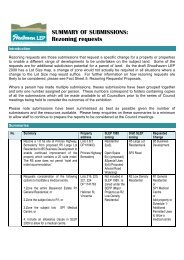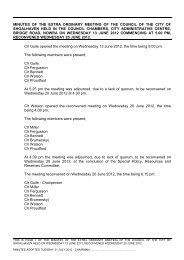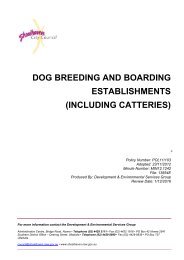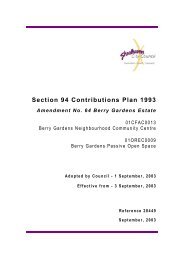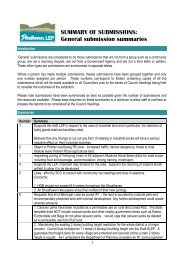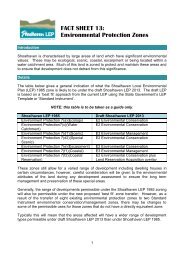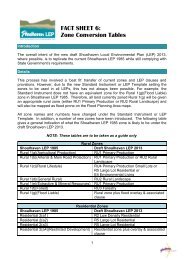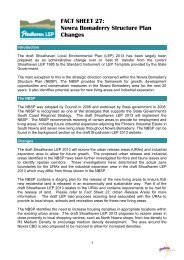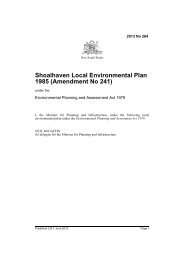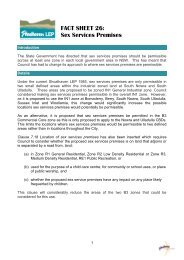Nowra CBD Master Plan – <strong>Market</strong> <strong>Assessment</strong>4. ANALYSIS OF LAND USE TRENDS4.1 Retail TrendsOver the past three decades significant changes have occurred in the retail industry such as the introduction of newtechnologies, the ageing of the population, increased female participation in the workplace and changing consumerpreferences. These changes have placed increased pressure on many existing retail centres to either adapt or losemarket share.In the 1980s, Australian retail floorspace totalled approximately 1.8sqm per person (excluding commercial space andautomotive retailing), which was roughly divided into equal components of regional, district and neighbourhood/localcentres. Today we have around 2.1sqm per capita due to increasing affluence and consumerism.The retail industry’s innovative nature is driven largely by the need to respond to, and anticipate, its customers’ needsand desires. Changing demographics and lifestyles require individual retailers and shopping centres to constantlymonitor these often subtle shifts and respond by repositioning their retail offer, presentation and mode of operation. Thefactors that are driving the changing face of retailing in Australia are described as follows:• The increase in the proportion of working women;• The increase in the proportion of part-time and casual employment and the reduction in full-time employment;• The reduction in the proportion of households that match the ‘traditional family’ model and an increase in thenumber of single persons and single parent households;• The increasing disparity of household income, ranging from high double income households to households thatrely on welfare;• The ageing of the population; and• Increasing working hours for those in full-time employment.In particular economic rationalism over the past three decades has resulted in increasing household income disparity.Today there are many families with high disposable incomes and many families that struggle in poverty. Families aretypically cash-rich / time-poor or time-rich / cash-poor. Very few families are both time-rich and cash-rich, whichprovides interesting challenges for the retail industry.Population growth, rising real disposable incomes and innovation and change within the retail industry haveunderpinned a rapid increase in the supply of retail floorspace throughout Australia. Population growth and increasinglevels of disposable income have provided the means to support new retail development, but it is the innovative natureof the industry itself that has generated major increases in more and larger centres.Without a doubt the ‘Global Financial Crisis’ has had an impact on the Australian retail property market in the pastcouple of years. The period from late 2007 to 2009 was characterised by weaker consumer sentiment and poor leasingand investment markets (i.e. weak income and capital returns). This trend was common to most commercial marketsnationwide.C09143 Page 18 Hill PDA
Nowra CBD Master Plan – <strong>Market</strong> <strong>Assessment</strong>The Federal Government’s stimulus package in 2009 was successful in reversing the downward trend in retailexpenditure. There are now clear signs that consumer sentiment is improving on the back of a strengthening economy,with a slow and steady recovery now underway.The long term trends of rising affluence, consumerism and technological change are likely to ensure that retailexpenditure will continue to increase over the long term owing to real growth in retail spend per capita. The currenteconomic climate is viewed as a short term condition rather than a long term one. In the future it is inevitable that therewill be periods of economic growth and adjustment.Recent retail trends and their implications are explained further below.Greater Size and DiversificationTraditionally retailing has followed a hierarchy from regional through district to small neighbourhood centres. In the1950s Australia’s first planned suburban shopping centres replaced the traditional strip centres that had built up aroundrailway stations. The ample, off-street parking and shopper amenity offered by these new enclosed malls appealed tocustomers, especially as motor vehicle usage increased and became more widely affordable. The first of thesesuburban centres to open was in Top Ryde in 1957.The introduction of the discount department store in the mid 1960s spawned a wave of new centre development andexpansion, which continued throughout the 1970s and early 1980s. In the late 1980s and early 1990s, retailinnovations such as food courts, in-centre cinemas, family entertainment centres, library, medical and other servicesand larger supermarkets further fuelled increases in centre size and numbers.Regional centres of more than 60,000sqm of floorspace began to evolve during this time. These centres generallyincorporated a department store, large major tenants and supermarkets. Roselands was the first of these to be built in1965 and today there are approximately 35 indoor centres in NSW with retail floor areas over 30,000sqm. The closestregional centre to Nowra is Stockland Shellharbour, which has a retail area of almost 34,000sqm.Somewhat later super-regional centres developed in NSW comprising both a David Jones and a Grace Brosdepartment store and having a total floor area of more than 100,000sqm. Such centres in NSW include Castle Towers,Erina Fair, Warringah Mall, Westfield Bondi Junction, Westfield Hornsby, Westfield Miranda and Westfield Parramatta.More recently these centres are housing a range of ‘category killers’ or ‘mini-major’ stores. Category killers are largestores, typically from 400sqm to 3,000sqm, that provide an extensive range and depth of competitively pricedmerchandise within a single market segment. Examples include Borders, JB-Hi-Fi, Dick Smith, Lindcraft and Rebel.Due to com petition between centres, there continues to be plans for expansion. Macarthur Square and WestfieldPenrith were recently expanded to more than 80,000sqm each. Even the super-regional centres like Macquarie Centre,Castle Towers, Warringah Mall are proposing further expansion. Top Ryde, the first suburban indoor centre, is beingredeveloped into a centre of 70,000sqm – almost four times its previous size.New UrbanismNew urbanism has gained popularity in the United States. The recent example of it here is the Rouse Hill Town Centre.Principally new urbanism refers to a return to a grid road pattern, more intense residential and employment related useswithin walking distance to centres and a return to a ‘main street’ theme rather than enclosed mall within the towncentres.C09143 Page 19 Hill PDA




